Instant Pot Pro Plus review: Instant's smartest cooker yet
The Instant Pot Pro Plus is one of the more expensive Instant Pots on the market, but we think it’s worth the splurge
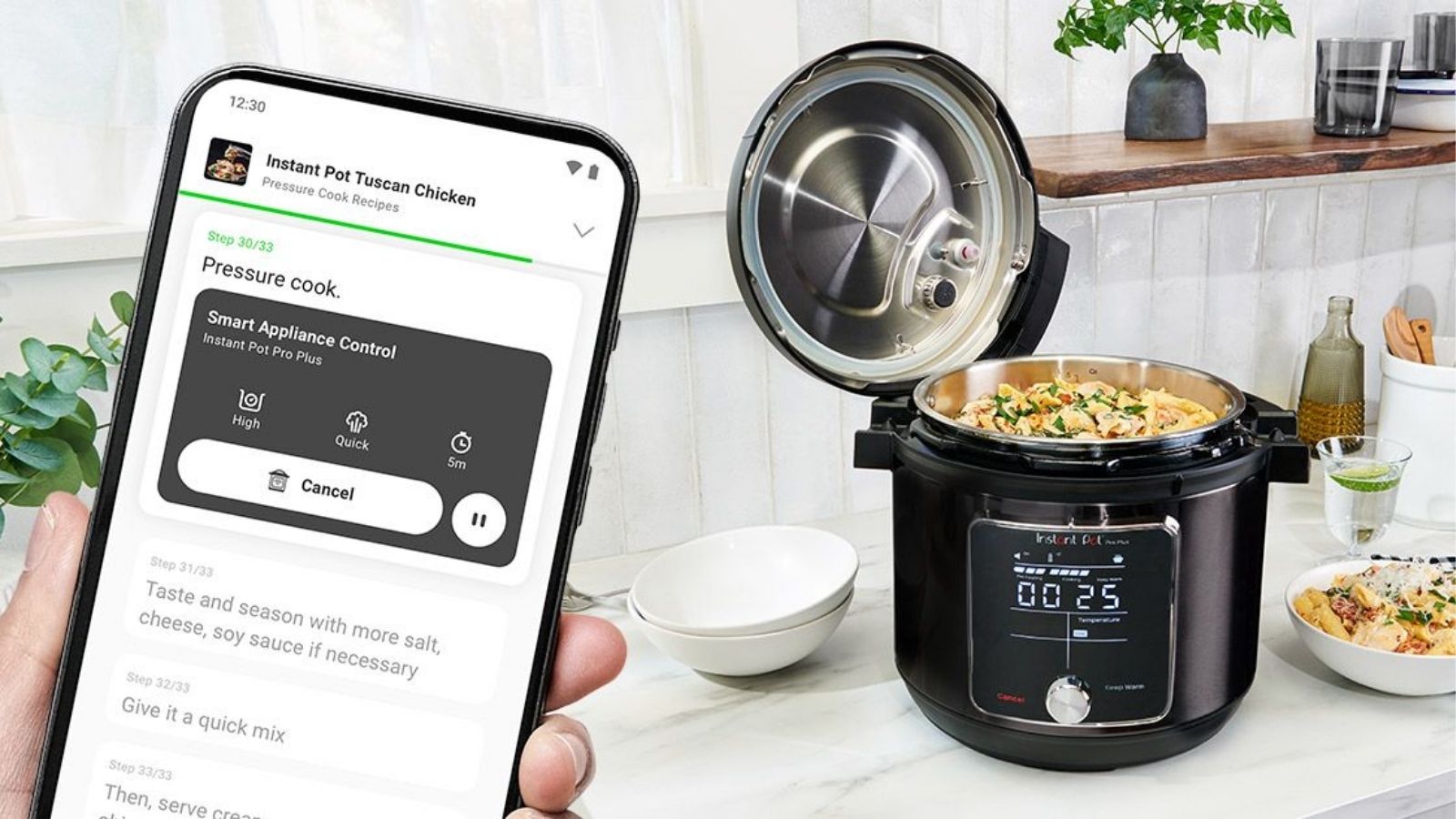
On the Instant Pot Pro Plus you’ll find the versatility and great cooking performance that made the original version a runaway success. However, this new model has design updates that make it the easiest to use Instant Pot yet.
-
+
Multifunctional and excellent at all its functions
-
+
Intuitive to program
-
+
Flat bottomed pot with handles
-
+
Programmable pressure release
-
+
Dishwasher safe
-
+
Works with an app
-
-
Expensive
You can trust Homes & Gardens.

With its ability to pressure cook, slow cook, steam rice, and more, the Instant Pot took the world by storm. The brand new Instant Pot Pro Plus has all of the multifunctionality of previous versions plus improvements that make it more convenient to use.
The Instant Pot Pro Plus has settings for pressure cook, rice, sauté, slow cook, steam, yogurt, sous vide, and canning. It also has a NutriBoost mode for use with pressure or rice cooking, which the company claims will help break down food, add nutrients and improve flavor and texture. It recommends using it for bone broth and risotto. You can also set the cooker to start at a preprogrammed time and to keep food warm after cooking or to reheat food for up to 10 hours at a low, high, or custom temperature. The only settings found on other Instant Pots that aren’t on this model are cake and sterilize, neither of which we expect most people will use often.
The control panel is extremely intuitive to operate and a flat bottom and handles on the cooking pot improve browning and maneuverability. After you connect this cooker to an app, you can use a mobile device to program it and access interactive recipes. It might just be the best Instant Pot to date.
First impressions of the Instant Pot Pro Plus

- Power: 1500W
- Capacity: 6 quarts
- Material: Stainless steel, aluminum, plastic
- Programs: Pressure cooker, slow cooker, rice cooker, steamer, sauté pan, yogurt maker, warmer, canning pot, sous vide, and NutriBoost
- Weight: 15.9 lbs.
- Size: 13.2'' x 13'' x 12.7'' ( l x w x h)
- Included: Stainless steel cooking rack, extra sealing ring (gasket), recipe booklet
The Instant Pot Pro Plus has a large silver control panel, about 5 ½ inch square, that gives it a high tech appearance. To select settings you touch the panel and then use a dial to adjust the cooking time. All of the settings are easy to read and completely intuitive to program. While it’s always a good idea to review the manual before you use a new product, from the git-go you can figure out how to use the Pro Plus without referring to the instructions. When it’s not in use, the panel goes to sleep so the Instant Pot looks sleek sitting on your kitchen countertop.
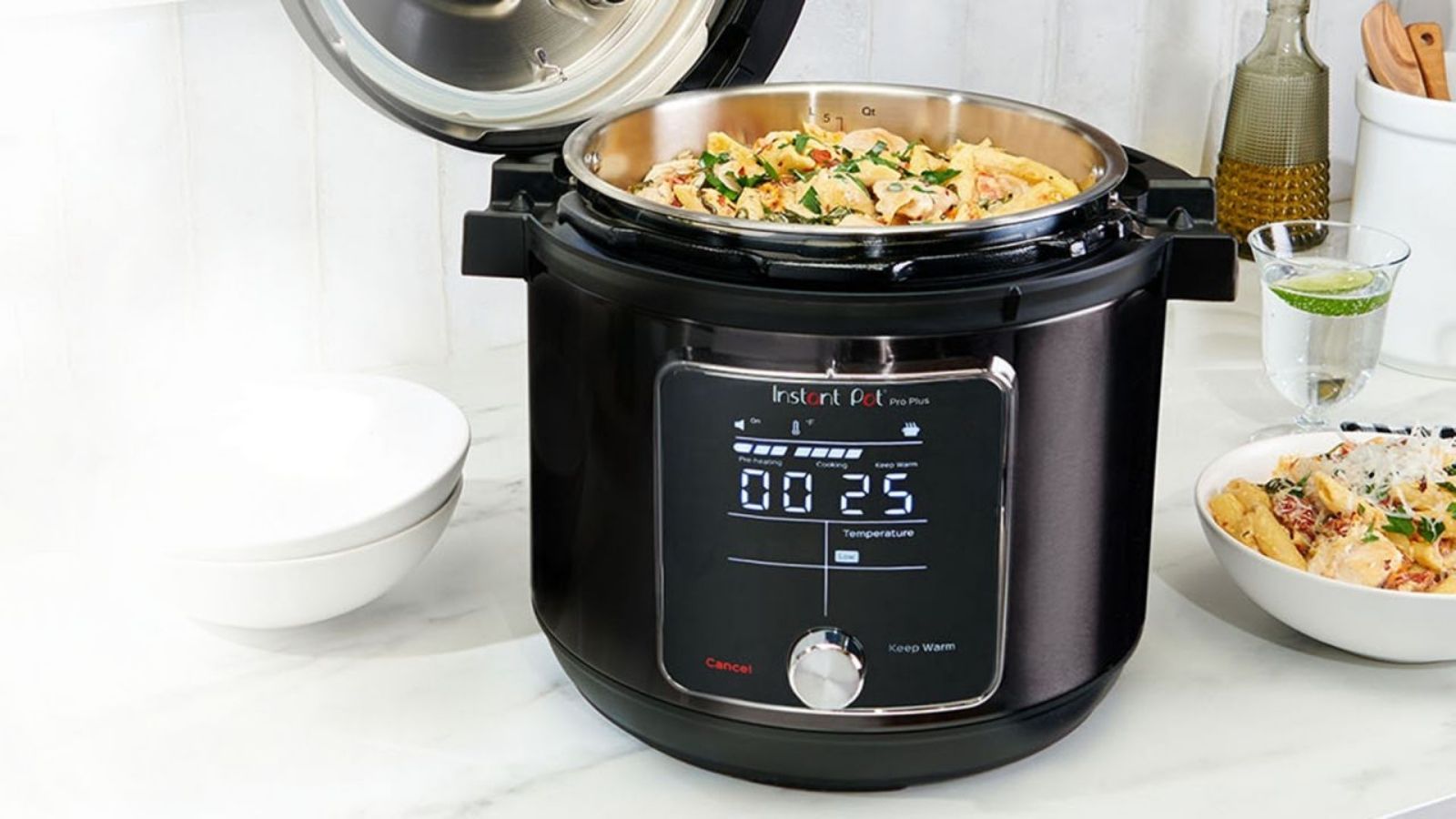
The bottom of the cooking pot is flatter than on other Instant Pots so that when you add oil, it evenly covers the entire surface; in addition, the base is thicker and the appliance has a higher wattage, all of which improve browning on the sauté function. On either side of the pot, there are handles that keep it anchored in place; when you stir foods, the pot doesn’t twirl around in the base. And of course, they make it very convenient to remove the pot.
When you place the lid on the cooker, it automatically seals. As there’s a lid over the pressure release valve, pressure is released gently and you don’t get those loud, alarming bursts of steam that you get with other pressure cookers. When you open the cooker to stir, add ingredients, or serve, you can lift off the lid and insert one of the tabs into one of the slots on the edge of the top of the base to keep your countertop clean. For pressure cooking, you can select the release setting at the beginning of cooking. In the upper left-hand corner of the display, a lighted icon appears when the pot’s under pressure. When it disappears, you know definitively that the pressure has dropped and you can safely open the lid.
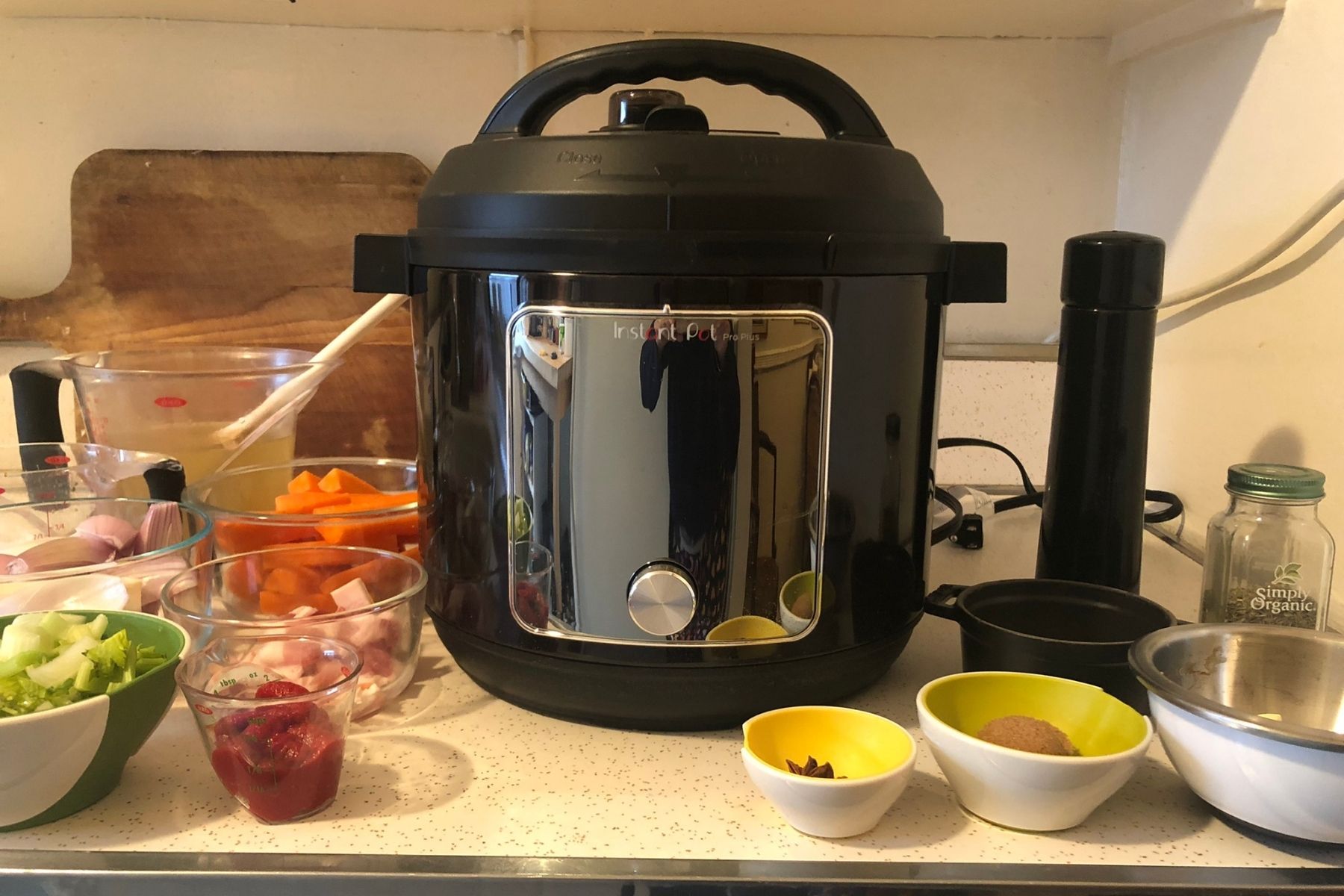
The most unique aspect of the Instant Pot Pro Plus is that through Wi-Fi and Bluetooth you can connect it to an app. You can then control the functions from your mobile device or take advantage of guided recipes. It was exceptionally easy to link up and the database features over 1500 recipes from multiple sources. Once you select a recipe and assemble the ingredients, you have the option of manually programming the recipe or pressing buttons on your device to automatically program each step and start timers. If you opt to use preprogrammed cooking, the instructions can be confusing.
Design expertise in your inbox – from inspiring decorating ideas and beautiful celebrity homes to practical gardening advice and shopping round-ups.
The interface on the Pro Plus itself is so easy to use, it didn’t seem to make sense to use a phone for programming, especially since you have to be in front of your cooker to add food, make adjustments to the settings, stir, put on the lid, and sometimes to press start on your phone. When you program the cooker itself, you feel like you have more control. However, the app offers you the option of automatically starting a timer on your phone for each step and that is a convenience. After all, when you leave the kitchen to fold the laundry or answer the door, it’s often hard to hear the appliance ding when cooking’s completed; you can also glance at your phone to see how much time is left, rather than go back to check the display.
An extra sealing ring or gasket, as well as a cooking rack, are included with the cooker. The accompanying manual thoroughly explains how to use and care for the Instant Pot Pro Plus and you also get a booklet with 14 contemporary and enticing recipes. However, there are no cooking charts in the manual. If you are looking for suggestions as to how long to cook rice or beans, steam vegetables, or pressure cook meat, you have to open the app or dig around on the company website. The suggested cooking times often differ from those given in the Instant Pot recipes or from the default times, which can leave you wondering what time to set. It takes some experimentation to determine the cooking times that you personally prefer.
Pressure cooking in the Instant Pot Pro Plus

I used the preprogrammed recipe for Ranchin’ Short Ribs in the app. The ingredient list was sloppy. Items were specified in amounts and by weight; oddly the weights were given down to the decimal, so for example, it called for 4 shallots or about 5.92 oz. It specified 5 pounds of short ribs or about 16 ¼.
Before pressure cooking, the recipe included several steps on the sauté setting: browning bacon, searing the ribs, and sautéing vegetables. For each step, I had to press Start Cooking and Set Timer. While everything cooked well, it took longer than the programmed times for each of the steps on sauté and I had to extend the cooking minutes. If I was planning out this recipe on my own, I would have seared the short ribs in a large skillet in which I would have been able to brown more ribs at once and start them pressure cooking sooner; but of course, I would have had another pot to clean.
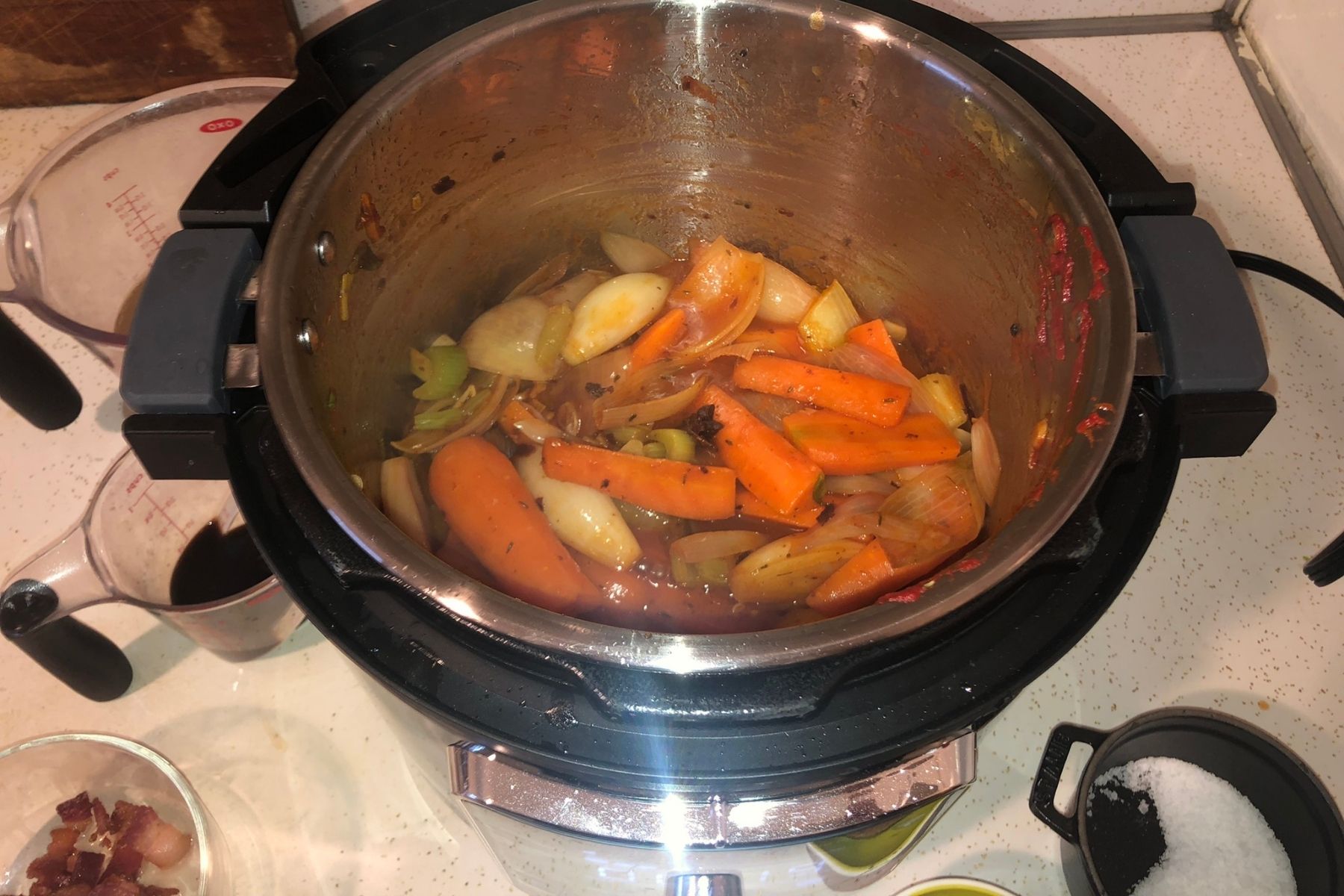
The app automatically programmed the pressure cooker level and the time. It took a half hour for the cooker to come up to pressure. At that point, the app began counting down the cooking time, which was helpful as I no longer had to be in front of the pot and could work at my desk in another room. After cooking was complete, it took 31 minutes for the pressure to drop naturally.
The end result was a delicious batch of short ribs in a rich, tangy sauce. As a pressure cooker, the Instant Pot Pro Plus was able to tenderize meat and produce a complex sauce in a fraction of the time that it would take on the stovetop or in the oven. Unlike on a stovetop pressure cooker, it wasn’t necessary to fiddle with the heat setting to maintain a steady pressure level.
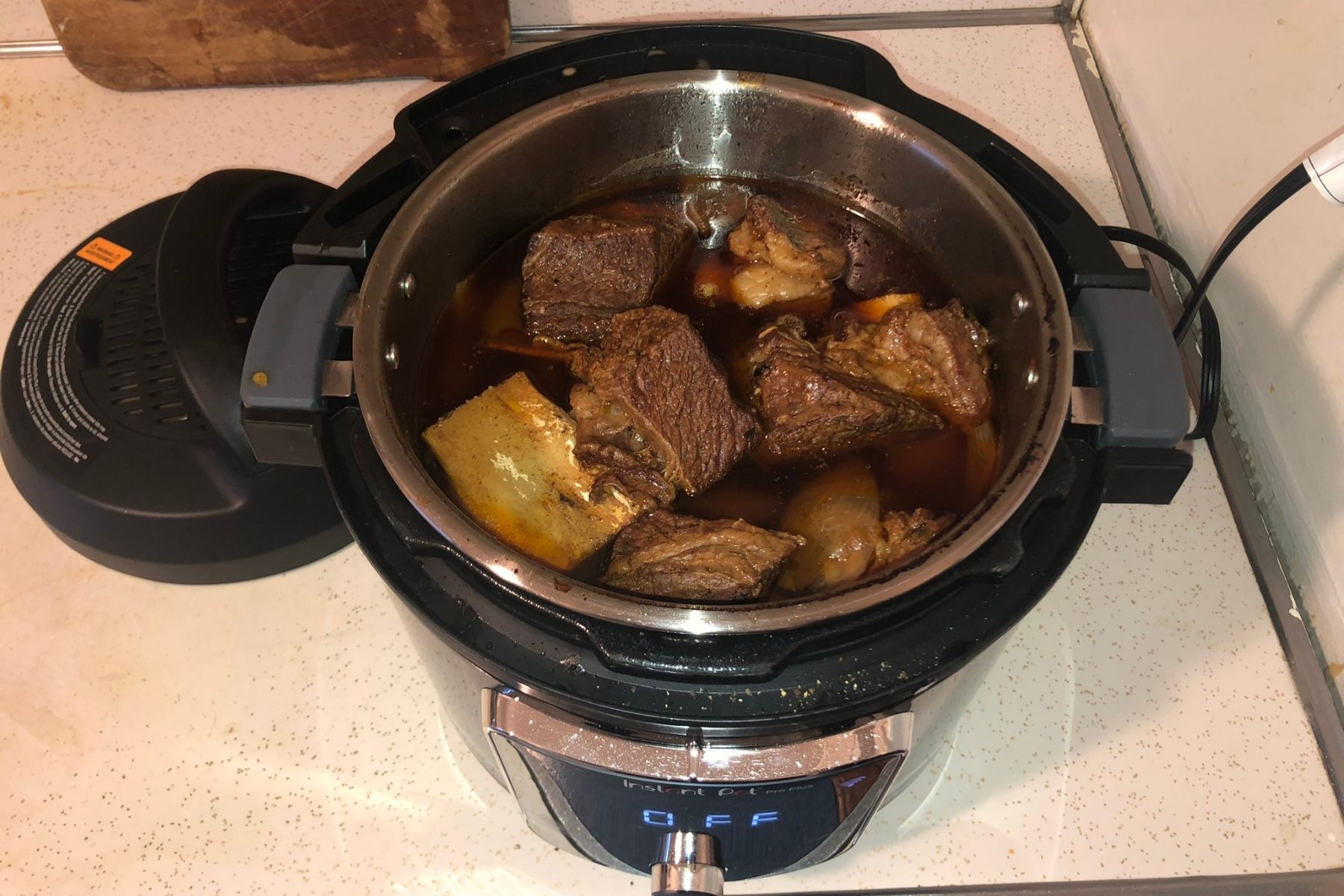
If you’re new to pressure cooking, you’ll quickly learn that although the actual cooking time is much shorter than by conventional cooking methods, browning meat, bringing the cooker up to pressure, and releasing the pressure take considerable time to the cooking process. In the case of the short ribs, it took 2 hours from start to finish, which is far faster than conventional cooking but long for an after-work dinner.
Slow cooking
To test the slow cooker function, I prepared a popular slow cooker recipe for Mississippi Roast, a thick chuck steak cooked with butter, pickled peppers, and seasonings that meld into a spicy gravy. Using the control panel, I programmed the roast to cook on the low setting for 6 hours. The meat came out tender enough to be pulled into pieces with two forks but retained its beefy flavor and texture. It didn’t turn out mushy, dry, or stringy as slow cooked roasts too often do.
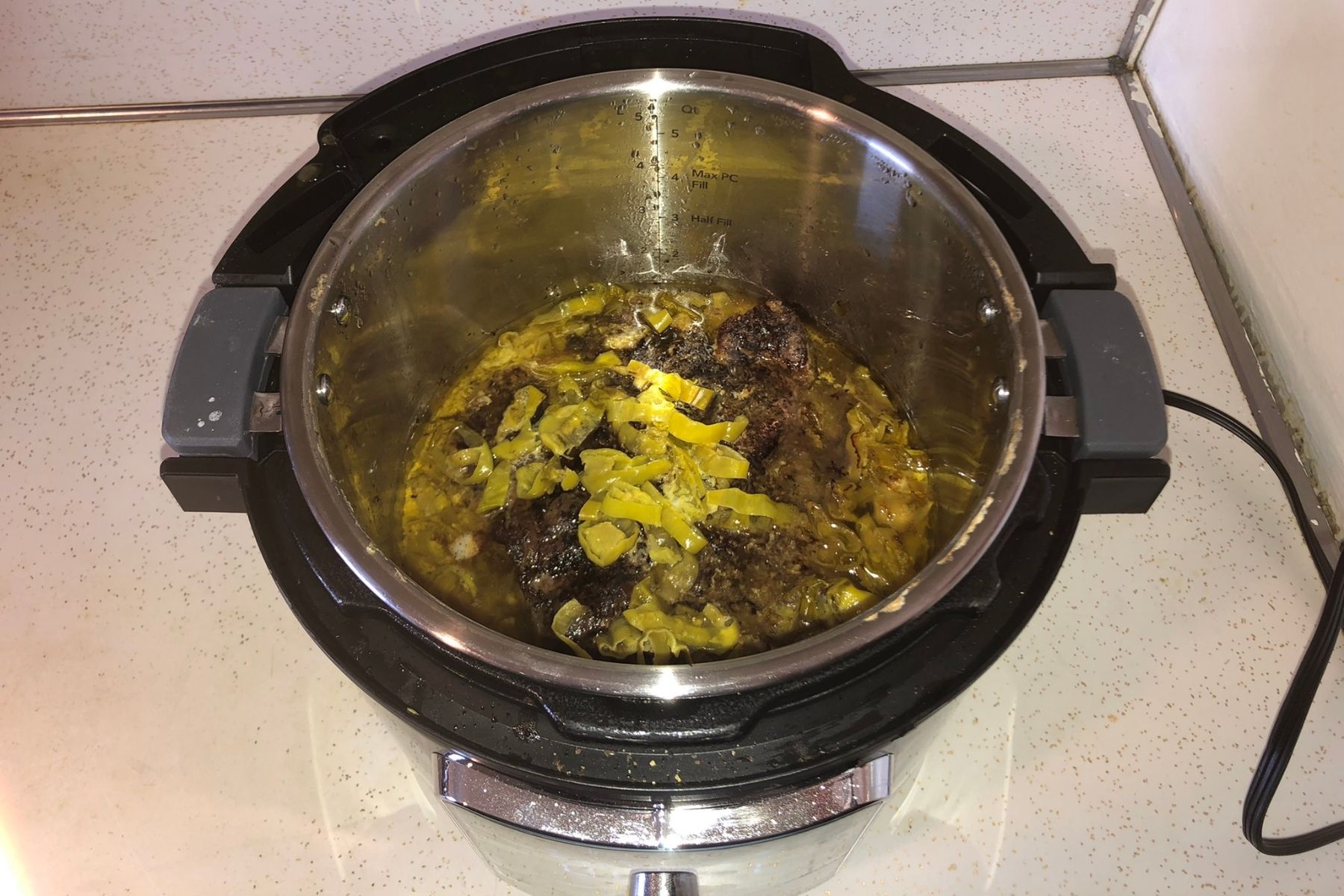
The only drawback that I see to using the Instant Pot Pro Plus in the place of the best slow cooker is that the 6-quart pot is tall and deep so you can’t cook a long cut of meat like a rack of ribs or a brisket of beef unless you cut it into pieces.
Steaming vegetables in the Instant Pot Pro Plus
I steamed 12 ounces of broccolini stalks, using 1 cup of water as called for in the vegetable cooking chart in the app. I used the control panel to program the machine and set the default time of 10 minutes. After a 6 minute preheat, the InstantPot Pro Pus began to steam. The broccolini came out tender, sweet tasting, and somewhat darker in color. For an al dente result, the cooking time would have needed to have been shortened. To cook 1 pound of carrot sticks, I set the Pro Plus for 5 minutes as recommended in the chart. I extended the cooking time by 10 minutes and still got a very al dente result.

The Instant Pot Pro Plus works well as a steamer but it requires trial and error to determine the correct cooking times for your preferred doneness for various foods.
Steaming rice
Using the app, I cooked 1 cup of long grain brown rice, opting for the app’s suggestions of using equal amounts of water and rice and a cooking time of 20 minutes. All of the water wasn’t absorbed by the rice and it came out slightly al dente. Next, I prepared 1 ½ cups of long grain white rice in the Instant Pot Pro Plus, manually programming the rice function.
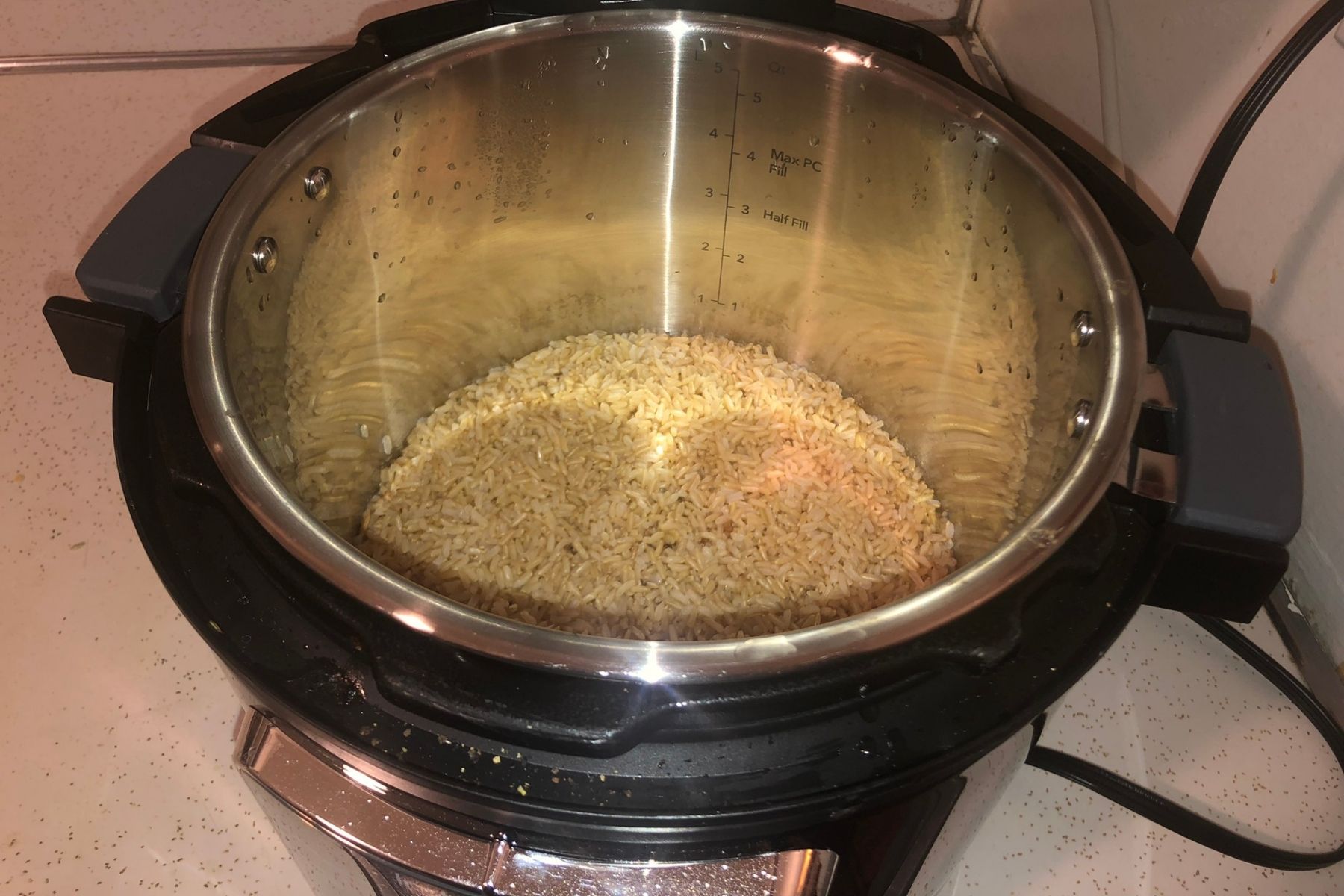
While I used equal amounts of rice and water as suggested by the chart, I used the default time of 12 minutes, rather than the 4 minutes suggested by the app. The rice came out with distinct grains and was moist and fluffy.
When I repeated the test, activating the NutriBoost feature, I got rice that was marginally moister and fluffier. In all tests, it took about 6 ½ minutes for the pressure to build up, or roughly equivalent to the time required to bring rice water to a boil. After steaming, it took about 9 minutes for the pressure to drop or about the time that it’s recommended rice rest before serving.
After some experimenting, to find the times that work best for your rice, the Instant Pot Pro Plus will work well as a rice cooker. It will steam faster than on the stovetop if you use a small quantity of rice. As you increase the amount of rice and water, the time to come up to and drop pressure will increase, canceling out the time saved for steaming.
Sautéing in the Instant Pot Pro Plus
When I made the Ranchin’ Short Ribs recipe to test the pressure cooker function, I used the sauté mode to brown the meat before cooking. After about a 4 minute preheat, oil in the pot was sizzling. The ribs browned very evenly and there was no burning or overcooking in any spots.
Before slow cooking the chuck roast that was called for in the Mississippi Roast recipe, I seared it on sauté and also got beautiful browning all across the surface of the meat. After cooking a strip steak sous vide, I seared it in the Instant Pot Pro Plus. It too browned quickly and evenly.
I found the Instant Pot Pro Plus’s ability to brown evenly without any burning impressive.

Making yoghurt
I followed the method for making yogurt in the recipe on the Instant Pot website for Yogurt Parfaits. However, I was disappointed that there was no recipe for plain yogurt in the materials that came with the unit, the app, or the website. However, the instructions were straightforward and worked well, resulting in a large amount of thick and creamy yogurt.
The Instant Pot Pro Plus is an effective way of heating milk and then maintaining it at a constant temperature for making yogurt. There is some preparation required at the beginning and the machine needs to remain on for about 10 hours.
Cooking sous vide
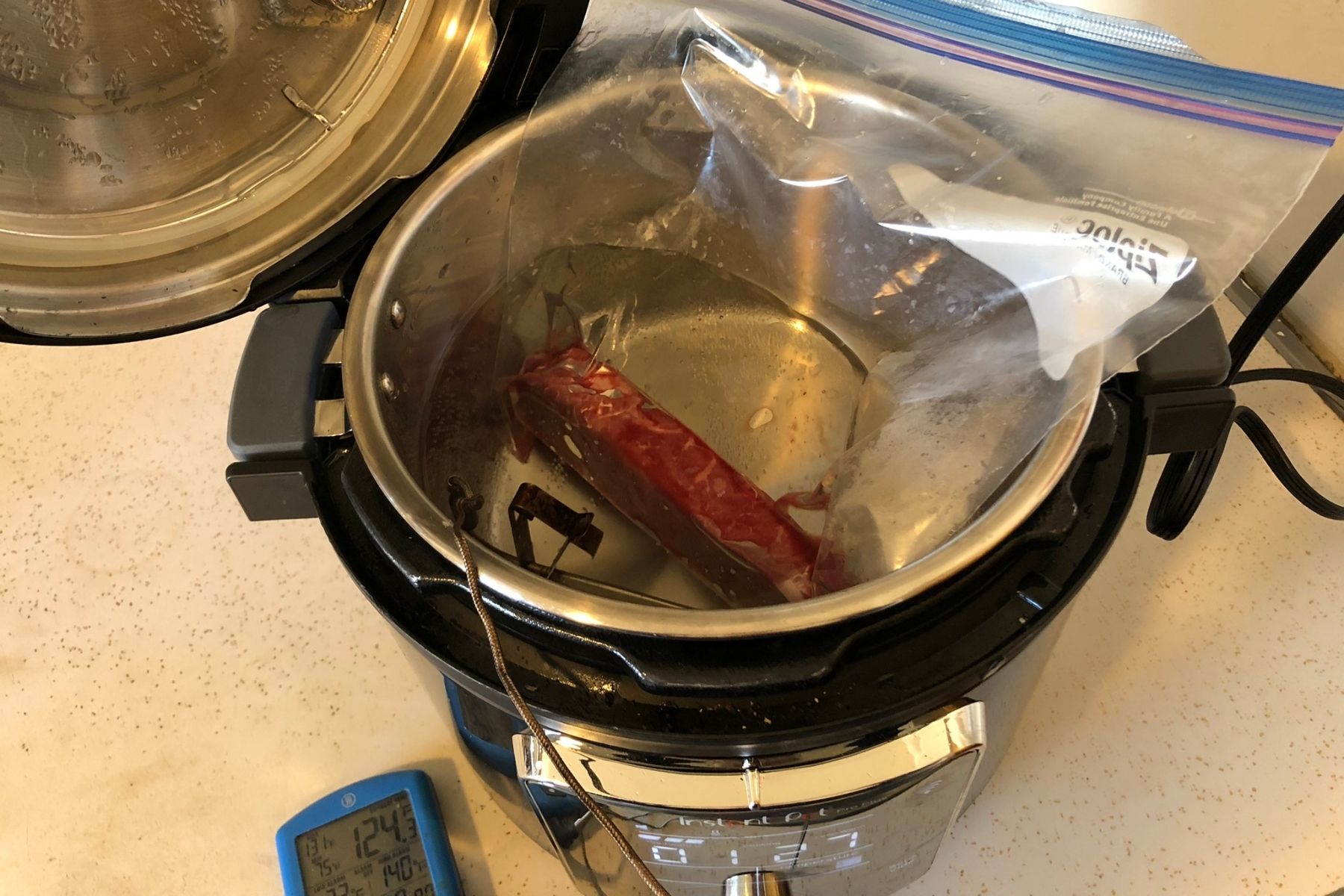
Sous vide is a method of cooking that involves bringing food to a desired temperature and then holding it at that temperature indefinitely. It is often used for bringing meats to a desired internal temperature before quickly searing them, thereby ensuring that they are cooked to the exact doneness that you prefer. In order to sous vide a boneless strip steak, I manually programmed the sous-vide function for 125°F and 1 ½ hours. It took about 30 minutes for the water to heat up and sous vide to begin. Over the hour and a half, the water in the cooker maintained a steady temperature of exactly 125°F.
If you are interested in sous vide cooking, it is a nice bonus to have the function built into the Instant Pot Pro Plus and not have to purchase and store an additional device.
Warming
After pressure cooking short ribs, the cooker automatically switched into the warm model. Over a 2 hour period, the temperature of the sauce dropped from a temperature of 210°F to 199°F. At those temperatures, the dish continued to simmer. Although the ribs were still delicious, they did become stringier during that time.
The warm mode can be programmed to low, high, or a custom temperature ranging from 77°F to 194°F. Using the high setting, I reheated 2 quarts of chili. It required 2 hours to reach an acceptable serving temperature of 160°F. It stayed between 160°F and169°F for 1½ hours. At that point, I turned to the low setting and within a half hour the temperature dropped to 151°F. Next, I entered a custom setting of 194°F and within 30 minutes, the temperature was raised to 193°F.
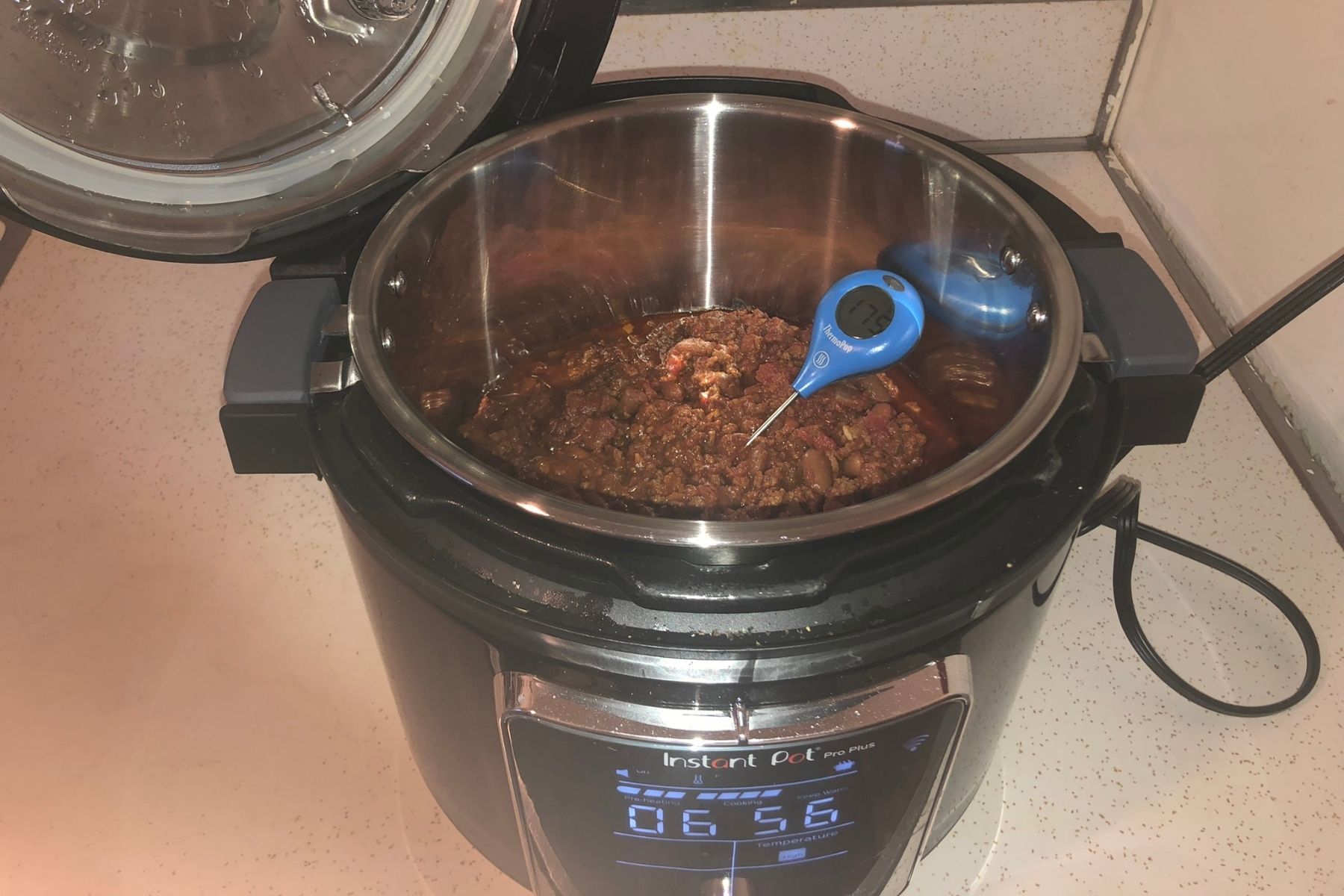
The low and high settings of the warm function can maintain food at a safe temperature. When you program at a precise temperature, it keeps food at that temperature. However, if food is very hot after being pressure cooked or cold from the refrigerator it will take time to lower or raise the temperature to the set one. It would not be advisable to keep food that had just been pressure-cooked on the warm function for an extended period of time if you don’t want it to overcook. For reheating, unless you are using a small portion, it would take an unreasonably long time to heat it up in the Instant Pot Pro Plus.
Cleaning
The inner pot and pressure-cooking lid are dishwasher safe. You can clean the lid in the dishwasher on the top rack if you remove the sealing ring, steam release valve, QuickCool protective cover, and steam release cover; those small parts need to be washed by hand. If you opt to wash the Instant Pot Pro Plus in the sink, all of the parts are easily cleaned, although the small parts and crevices in the lid and the sealing ring require a little detail work.
Should you buy the Instant Pot Pro Plus?
If you’re looking for a multicooker and want all the bells and whistles you can possibly get, the Instant Pot Pro Plus is worth its high price. You’ll find it looks like a premium product and really can function as a pressure cooker, slow cooker, rice maker, steamer, and sous vide device as well as make yogurt. It can also warm up food although its usefulness for that function is limited. In one trial, the NutriBoost mode seemed to make a very small difference.
Although it can be used as a canner, I did not test it for that function as the USDA is not definitive on whether or not canning should be done in pressure cookers. According to Instant Brands, the Instant Pot Pro Plus has been tested to operate at the required temperature ranges for all types of canning as per USDA home canning guidelines. The company does say that it is important to follow recipes closely when canning and that modifying cooking times, procedures, ingredients, or temperatures can be dangerous. If you are interested in canning, we suggest that you purchase a device intended exclusively for that purpose.
If you will use at least 2 or more of the various functions, we think the Instant Pot Pro Plus is a good buy. However, if you’re on a budget, you can get very good results, if a little less convenience, from one of the older Instant Pot models. You can connect the Instant Pot Plus with an app through WiFi and Bluetooth to give you access to a large collection of recipes that you can program yourself or through the app. Even if you’re a techy person, you may find it easier to program the recipes on the cooker than on your phone but the large selection of dishes to choose from is a nice bonus.
About this review, and the reviewer
Sharon Franke is a journalist who specializes in testing and writing about kitchen equipment. A thirty-year veteran of the Good Housekeeping Institute, Sharon also worked as a professional chef in New York City restaurants for seven years.
In her free time, she is an avid home cook who is in the process of mastering the art of sourdough bread baking.

Sharon Franke is a journalist who specializes in testing and writing about kitchen equipment. A thirty-year veteran of the Good Housekeeping Institute, Sharon also worked as a professional chef in New York City restaurants for seven years. In her free time, she is an avid home cook who is in the process of mastering the art of sourdough bread baking.